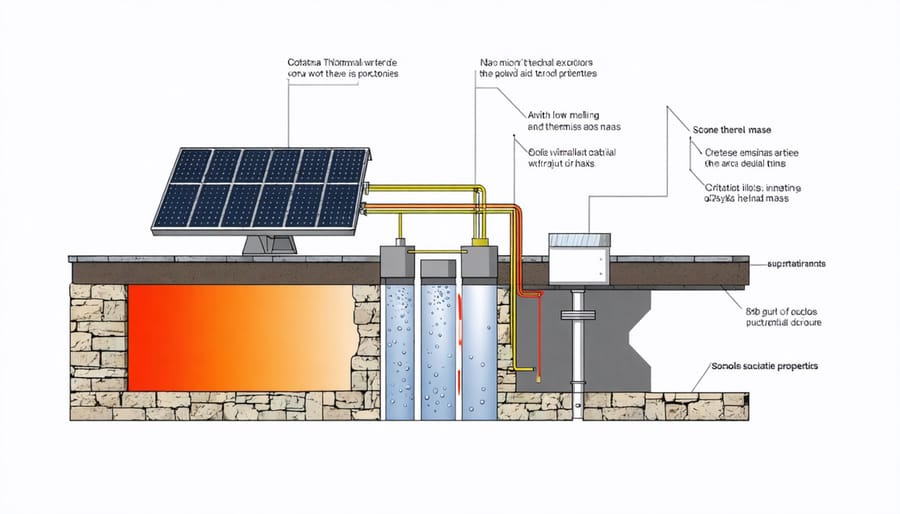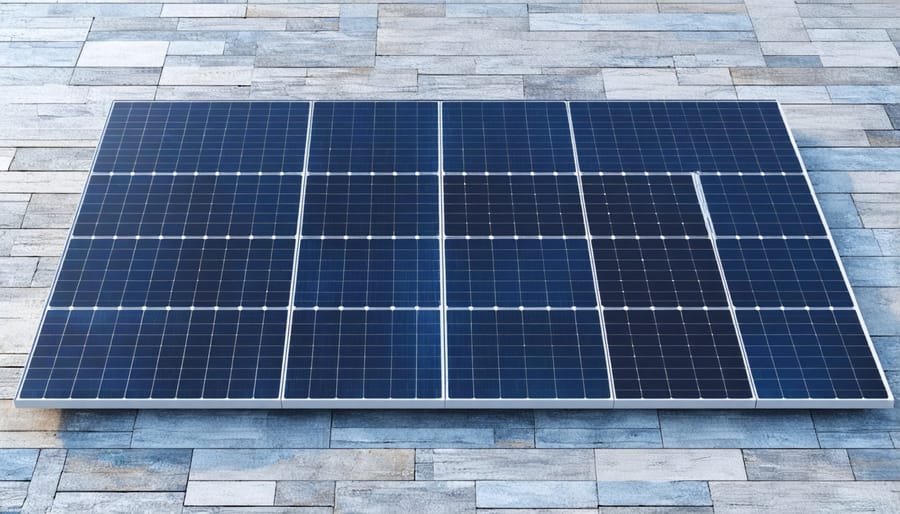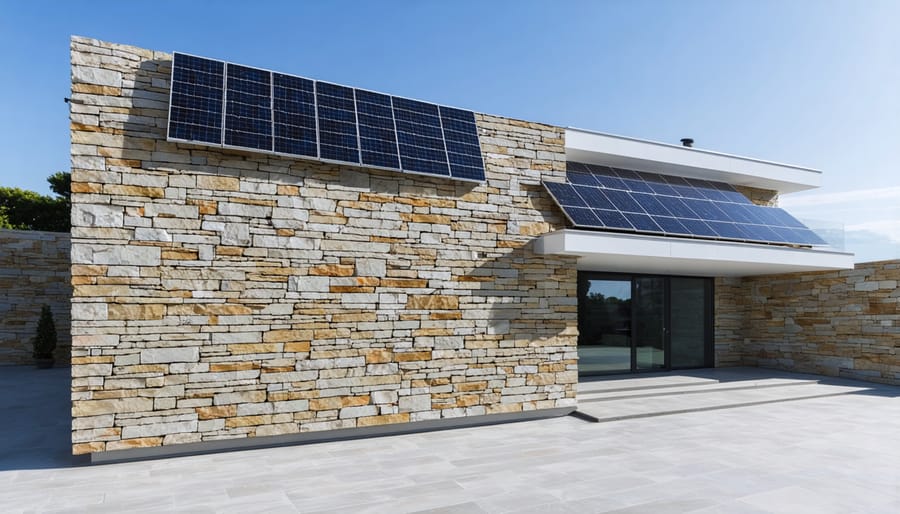At the intersection of sustainable architecture and timeless design, solar energy integration with natural stone is revolutionizing how we approach modern building aesthetics. Solar-enhanced stone applications merge ancient building materials with cutting-edge renewable technology, creating structures that are both energy-efficient and visually striking. From solar-absorbing granite facades that help regulate indoor temperatures to photovoltaic-embedded limestone pathways that generate electricity, these innovations are transforming passive stone surfaces into active energy contributors.
The marriage of solar technology and stone design opens new possibilities for architects and homeowners alike. Traditional stone elements – whether in walls, flooring, or landscaping features – can now serve dual purposes, maintaining their classical appeal while harnessing the sun’s power. This transformation is particularly significant in regions where abundant sunlight meets the need for sustainable building solutions.
As climate consciousness grows and energy efficiency becomes paramount in construction, the integration of solar capabilities with stone design represents more than just an architectural trend – it’s a practical solution for future-focused building development. These applications demonstrate how traditional materials can evolve to meet contemporary energy needs without sacrificing their inherent beauty and durability.
How Natural Stone and Solar Technology Work Together
Thermal Mass Properties
The thermal mass properties of stone make it an exceptional material for solar energy applications. Natural stone’s ability to absorb, store, and gradually release heat creates a natural thermal battery effect that enhances the efficiency of solar heating systems. During daylight hours, stone elements absorb solar energy, storing it within their dense structure. As temperatures drop, this stored heat is slowly released back into the surrounding space, helping to maintain consistent indoor temperatures and reduce heating costs.
Different types of stone vary in their heat retention capabilities, with darker, denser varieties typically offering superior thermal mass performance. For example, granite and slate can store approximately 0.84 BTU per pound for each degree Fahrenheit increase in temperature, while limestone stores about 0.72 BTU. This natural heat storage capacity makes stone an ideal companion material for passive solar design strategies, particularly in climate zones with significant temperature fluctuations between day and night.
When properly integrated into building design, stone’s thermal properties can help reduce HVAC energy consumption by up to 25% while providing a durable, aesthetically pleasing architectural element.

Integration Methods
Solar energy integration with stone design can be achieved through several innovative methods, each offering unique advantages. The most common approach involves embedding photovoltaic cells directly into stone veneers, creating a seamless blend of natural aesthetics and renewable energy generation. These integrated panels can be installed flush with the stone surface, maintaining the material’s natural beauty while harnessing solar power.
Another effective technique is the installation of solar thermal collectors behind stone façades, utilizing the stone’s natural thermal mass properties. This method is particularly effective in climate control applications, where the stone acts as a heat sink while concealing the solar components.
Modern manufacturing processes now allow for the creation of specialized stone tiles with built-in solar receptors. These hybrid materials can be used in both vertical wall applications and horizontal surfaces like patios or walkways. For existing stone structures, retrofit solutions include mounting specially designed solar panels that complement the stone’s color and texture, creating a harmonious appearance.
Some designers opt for indirect integration, using stone elements to frame or support separate solar installations, creating an architectural statement that celebrates both materials’ unique properties.
Innovative Solar Applications in Stone Design
Solar-Integrated Stone Facades
Solar-integrated stone facades represent a groundbreaking fusion of traditional architecture and renewable energy technology. These innovative systems combine photovoltaic (PV) panels with natural stone cladding, creating building exteriors that are both energy-generating and aesthetically pleasing. The integration process typically involves mounting thin-film solar panels or crystalline PV modules onto ventilated stone facade systems, maintaining the natural beauty of stone while harnessing solar power.
Modern installation techniques allow for seamless incorporation of solar panels between stone panels or as overlay systems that complement the stone’s natural patterns. This approach preserves the timeless appeal of stone facades while adding crucial functionality. The stone backing provides excellent thermal mass properties, enhancing the overall energy efficiency of the building envelope.
Notable examples include the Swiss Alps Hotel in Zermatt, where local granite facades incorporate hidden solar cells, generating up to 20% of the building’s electricity needs. In urban applications, mixed-media facades combining polished granite with integrated PV panels have become increasingly popular among contemporary architects.
The key benefits extend beyond energy generation. These integrated systems offer superior weatherproofing, reduce thermal bridging, and can contribute to LEED certification points. Additionally, the natural durability of stone provides excellent protection for the solar components, potentially extending their operational lifespan beyond traditional roof-mounted systems.
For optimal performance, designers must carefully consider factors such as stone type, panel orientation, and local climate conditions. The most successful installations typically feature lighter-colored stones to minimize heat absorption and maximize energy efficiency.

Stone Solar Thermal Systems
Stone solar thermal systems harness the natural ability of stone to absorb, store, and gradually release heat, creating efficient and sustainable heating solutions for buildings. These systems leverage the energy efficiency benefits of natural stone by combining traditional stone materials with modern solar technology.
The principle behind these systems is straightforward: stone elements, typically installed in walls or flooring, are designed to capture solar heat during the day. This heat is then slowly released during cooler periods, providing natural temperature regulation. Dark-colored stones, such as slate or granite, are particularly effective due to their superior heat absorption properties.
Common applications include solar stone walls, which feature a glazed exterior layer that traps solar energy, and thermal mass flooring systems that utilize stone’s heat retention capabilities. These installations can significantly reduce heating costs while maintaining comfortable indoor temperatures.
Modern stone solar thermal systems often incorporate advanced features such as integrated water circulation systems or phase-change materials to enhance their effectiveness. When properly designed, these systems can provide up to 30% reduction in heating energy consumption while adding architectural interest to the space.
For optimal performance, factors such as stone type, thickness, placement, and local climate conditions must be carefully considered during the design phase. Professional installation ensures proper integration with existing HVAC systems and maximizes the thermal benefits of the stone elements.
Decorative Solar Stone Features
Modern landscaping has embraced the fusion of natural stone and solar technology, creating stunning solar-integrated stone features that combine beauty with sustainability. These innovative designs range from illuminated stone pathways to sophisticated garden sculptures that harness solar energy during daylight hours.
Popular applications include solar-powered stone pillars that serve as elegant entrance markers, providing soft ambient lighting after sunset. Garden walls incorporating photovoltaic cells seamlessly blend into the stonework, creating self-sufficient lighting solutions that enhance security while maintaining aesthetic appeal.
Stone birdbaths and fountains equipped with solar pumps offer sustainable water features that operate independently of grid power. These elements create peaceful outdoor environments while demonstrating environmental responsibility. Designers are also incorporating solar-collecting crystals within stone benches and decorative walls, which store energy to power subtle lighting effects or charge small devices.
The latest innovations include thermochromatic stone treatments that respond to solar heat, changing colors throughout the day to create dynamic visual effects. These features not only serve practical purposes but also become conversation pieces that showcase the possibilities of combining traditional materials with modern technology.
When selecting decorative solar stone features, consider factors such as local sun exposure, desired lighting intensity, and maintenance requirements to ensure optimal performance and longevity.

Practical Considerations for Implementation
Cost Analysis
Integrating solar energy features with stone design requires careful consideration of initial investments and long-term benefits. While traditional cost analysis of stone installations typically focuses on material and labor expenses, solar integration adds another layer of financial planning.
The initial investment for solar-enhanced stone features varies significantly based on project scope. Small-scale applications, such as solar-powered stone pathway lighting, might range from $1,000 to $5,000. Larger installations, including solar-integrated stone facades or thermal mass walls, can range from $15,000 to $50,000 or more.
However, these systems often provide substantial returns through energy savings. Solar-thermal stone walls can reduce heating costs by 20-30% annually, while photovoltaic-integrated stone facades can generate electricity worth $800-1,200 per year for average-sized installations. Government incentives and tax credits can offset 26-30% of initial costs, making the investment more attractive.
Maintenance costs are relatively low, as most solar components have 20-25 year warranties, and natural stone requires minimal upkeep. The payback period typically ranges from 5-10 years, depending on energy prices and usage patterns. When factoring in property value increases of 4-6% for homes with solar-stone integration, the long-term financial benefits become even more compelling.
Maintenance Requirements
Solar-stone installations require regular maintenance to ensure optimal performance and longevity. The maintenance needs can be divided into two main components: the solar elements and the stone surfaces.
For the solar components, quarterly inspections are recommended to check for dust accumulation, debris, or damage. Clean solar panels using soft brushes and specialized cleaning solutions to maintain maximum energy absorption. During winter months in colder climates, snow removal may be necessary to prevent weight stress on the installation and maintain efficiency.
Stone surfaces integrated with solar installations need annual inspection for signs of weathering, moisture penetration, or structural issues. Pay particular attention to connection points between solar mounting systems and stone surfaces, checking for any loosening or wear. Sealants and waterproofing materials should be evaluated every two years and reapplied as needed.
Professional maintenance services are recommended for complex installations, especially those involving sophisticated tracking systems or extensive stone facades. However, basic cleaning and visual inspections can often be performed by property owners or facility managers.
Keep detailed maintenance records, including dates of inspections, cleaning sessions, and any repairs. This documentation helps track performance patterns and anticipate future maintenance needs. Most solar-stone installations, when properly maintained, can provide reliable service for 20-25 years with minimal degradation in performance.
For optimal results, coordinate maintenance schedules with seasonal changes and local weather patterns to ensure both the solar components and stone elements receive appropriate care throughout the year.
Future Trends and Developments
The integration of solar technology with natural stone is poised for remarkable advancement in the coming years. Industry experts anticipate several groundbreaking developments that will revolutionize how we combine these two sustainable materials.
Transparent solar cells are emerging as a game-changing technology, allowing stone surfaces to harvest solar energy while maintaining their natural aesthetic appeal. These cells can be seamlessly integrated into stone veneers and facades, effectively turning entire building surfaces into power generators without compromising their visual appeal.
Smart stone-solar hybrid materials are under development, incorporating photovoltaic properties directly into engineered stone compositions. These materials promise to blend the durability of natural stone with efficient energy generation capabilities, potentially eliminating the need for separate solar panels altogether.
Nanotechnology applications are expected to enhance the efficiency of solar-stone integration. Scientists are working on nano-coatings that can improve the solar absorption properties of stone surfaces while maintaining their natural characteristics. These innovations could lead to more efficient energy harvesting from stone surfaces exposed to sunlight.
3D-printed solar stone elements are gaining traction, allowing for complex geometric designs that maximize solar exposure while creating striking architectural features. This technology enables the creation of custom stone pieces with integrated solar capabilities, opening new possibilities for innovative building designs.
Energy storage solutions specifically designed for solar-stone applications are being developed. These systems will allow excess energy generated during peak sunlight hours to be stored within the stone structure itself, potentially using phase-change materials or advanced battery technologies integrated into the stone matrix.
The industry is also moving towards AI-powered optimization systems that can adjust solar-stone installations in real-time to maximize energy collection. These systems will consider factors such as sun position, weather conditions, and energy demand to optimize performance throughout the day.
Looking ahead, we can expect to see increased standardization of solar-stone integration methods, making these solutions more accessible and cost-effective for both residential and commercial applications. The development of plug-and-play systems will simplify installation and maintenance, potentially leading to wider adoption across the construction industry.
As sustainability requirements become more stringent worldwide, these innovations in solar-stone technology will likely play a crucial role in meeting future building energy standards while preserving the timeless appeal of natural stone in architecture.
The integration of solar energy with stone design represents a powerful fusion of sustainability and architectural excellence. By combining the timeless appeal of natural stone with modern solar technology, property owners can achieve both aesthetic sophistication and significant energy efficiency. These innovative solutions not only reduce environmental impact but also offer substantial long-term cost savings through decreased energy consumption. The versatility of solar-stone applications, from façade systems to decorative elements, demonstrates their adaptability to various design requirements and architectural styles. As we move toward a more sustainable future, the adoption of solar-stone solutions offers a practical path forward for those seeking to blend traditional building materials with renewable energy technology. Whether for residential or commercial projects, this combination provides a compelling answer to modern construction challenges while preserving the enduring beauty of natural stone.










